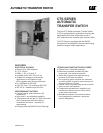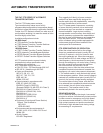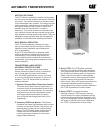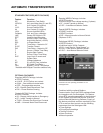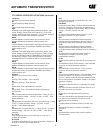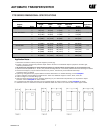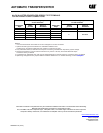
AUTOMATIC TRANSFER SWITCH
LEHE4651-04
2
THE CAT CTS SERIES OF AUTOMATIC
This ruggedly built family of power contactor
TRANSFER SWITCHES
switches has been specifically designed for
transfer switch duty with dependability, versatility
The Cat CTS Series power contactor and user friendliness of prime concern.
Type transfer switch makes use of a fully
programmable/configurable microprocessor-based
controller to allow the utmost in application flexibility.
Further, the CTS Series is offered in a wide array of
configurations enabling it to meet the needs of even
the most highly critical load.
The CTS power panel components, consisting
of power switching contacts, drive mechanism
and terminal lugs, are mounted on a specially
formed backplane. Logic devices including
microprocessor control auxiliary time delays and
special accessory equipment are assembled on
the door for ease of maintenance and separation
Available configurations include: from the power section. They are connected
40-4000 Amps:
with a numbered wiring harness equipped with
● CTS Automatic Transfer Switches a disconnect plug that allows isolation of the
● CTSD Delayed Transition Transfer Switches control panel for maintenance.
● CTSM Manual Transfer Switches
100-4000 Amps: CTS SERIES METHOD OF OPERATION
● CTSCT Closed Transition Transfer Switches When the normal source fails or the voltage
● CBTS Automatic Transfer/Bypass Switches drops to a predetermined point (usually 80% of
● CBTSD Delayed Transition Bypass Switches nominal), if required, a circuit is closed to start
● CBTSCT Closed Transition Bypass Switches the engine generator set. When the emergency
source reaches 90% of rated voltage and 95% of
All CTS products meet or exceed industry rated frequency, the drive solenoid is energized
requirements to allow specification and through the emergency coil control relay, causing
installation with confidence. the main contacts to disconnect the load from
● UL 1008 listed through 480 VAC the normal source and connect it to the
emergency source. After the drive solenoid has
completed its electrical stroke and is seated, the
emergency coil control relay opens to disconnect
it. The transfer switch is now mechanically locked
in the emergency position. When normal voltage is
restored to a predetermined point (usually 90% of
nominal), the control voltage sensing energizes.
The normal side coil relay closes, and after the
drive solenoid has completed its electrical stroke
and is seated, the coil control relay opens to
disconnect it. The transfer switch is now
mechanically locked in the normal position.
● CSA C22.2 No. 178 listed through 600 VAC
● IEC 947-6-1 listed through 480 VAC
● Codes and Standards
NFPA 70, 99, 101, 110
NEC 517, 700, 701, 702
IEEE 446, 241
NEMA ICS2-447
● Controls tested in accordance with:
IEEE 472 (ANSI C37.90A)
EN55022 Class B (CISPR 22)
(Exceeds EN55011 & MILSTD 461 Class 3)
EN61000-4-2 Class B (Level 4)
EN61000-4-3 (ENV50140) 10v/m
DRIVE MECHANISM
EN61000-4-4
EN61000-4-5, IEEE C62.41 All CTS switches employ the simple “over-center”
principle to achieve a mechanically locked position
in either normal or emergency and a high speed
drive assures contact transfer in 100 ms or less.
High contact pressure and positive mechanical
lock allow for high withstand and closing ratings,
far exceeding UL requirements.
EN61000-4-6 (ENV50141)
EN61000-4-11
● Equipment (Controls and Power Section)
Seismic Test Qualified to:
IBC-2003
IEEE-693-2005
● Enclosures meet the requirements of:
UL 508, UL 50, ICS 6, ANSI C33.76 and
NEMA 250
● Quality System:
ISO 9001 Registered



